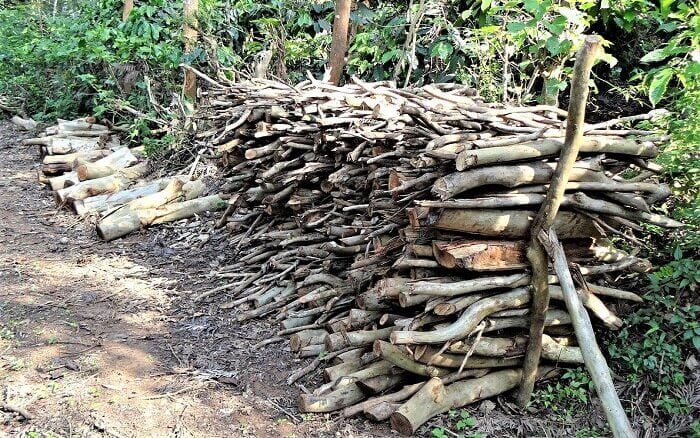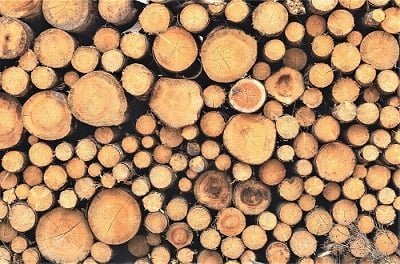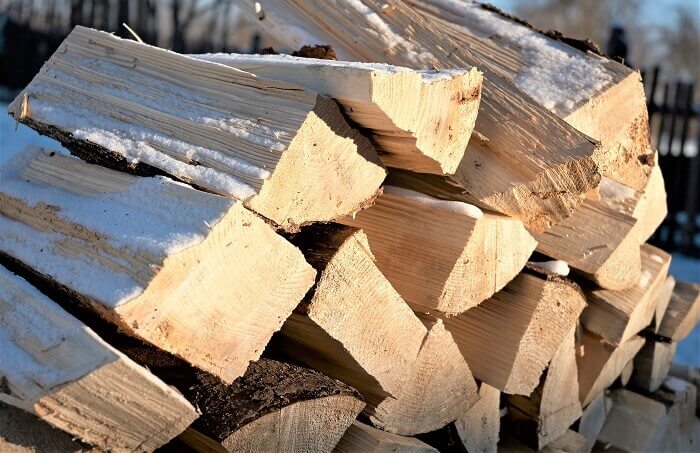How to Tell If Firewood is Ready to Burn
Note: This article may contain affiliate links, which means if you make a purchase following our links won’t cost you extra, but we may earn a commission. Learn more
If you’ve ever gone to gather firewood only to find that it’s damp and won’t burn, you know the importance of being able to tell if the wood is ready to burn. There are a few key things you can look for to determine if your wood is dry enough to burn.
The first is the color of the wood. Freshly cut wood will be a light color like white or pale yellow. As it dries, it will change to a darker brown. If the wood is still pale, it’s not ready yet.
The next thing you can check is the weight of the piece of wood. When wet, firewood is very heavy and difficult to lift. Once it’s dried out, it will be much lighter and easier to carry. You should be able to tell by picking up a piece whether or not it’s ready yet.
Take a look at the end of the piece of wood where it was cut. If there is still moisture seeping from the center of the log, it’s not ready yet.
How Do I Know If the Wood is Ready to Burn?
If you’re lucky enough to have a wood-burning stove or fireplace, you know that there’s nothing quite like the crackle and warmth of a real wood fire. But before you can enjoy that cozy feeling, you need to make sure your wood is properly seasoned and ready to burn. Here are a few tips on how to tell if your wood is ready to go:
1. The Wood Should Be Hard
This is probably the most obvious sign that your wood is ready to be burned. If it’s still soft or spongy to the touch, it’s not going to give you much heat or produce much flame. Seasoned wood should be hard and dry all the way through.
2. The Wood Should Make a Sharp Sound When Hit Together
Another way to tell if your wood is properly seasoned is by giving it a knock. If it makes a dull thud sound, it’s still too wet and needs more time seasoning. But if it produces a sharp noise, then it’s good to go!
3. The Ends of the Wood Should Be Cracked
You’ll notice that as wood seasons, cracks will start appearing on the ends of the logs (this is called “checking”). This means that the moisture inside the log has started evaporating and escaping out through these cracks – perfect for burning in your fireplace!
4. The Wood Should Be Aged at Least 6 Months
Even if all of the above criteria are met, unseasoned wood can still pop and spit when burned in your fireplace (not fun). To avoid this, make sure your logs have been cut and split for at least 6 months before burning them – this will give them plenty of time to fully season.
Following these tips will help ensure that you’re getting the most out of your wood-burning experience – both in terms of heat output and safety!

Can You Burn Freshly Cut Firewood?
If you’ve just cut down a tree and want to use the wood for firewood, you may be wondering if it’s okay to burn freshly cut wood. The answer is yes, but freshly cut wood will have a high moisture content, which means it will produce less heat and create more smoke than dry wood.
It’s important to let freshly cut wood sit for at least six months before burning it so that it has time to season and dry out. Another thing to consider is the type of tree the wood came from. Hardwoods like oak and maple burn better than softwoods like pine and cedar.
If you’re not sure what kind of tree your firewood came from, ask your local sawmill or firewood dealer. And make sure you split the logs into small pieces before trying to burn them. Freshly cut wood is hard to ignite, so smaller pieces will help get the fire going more easily.
How Long Does It Take for Cut Wood to Be Ready to Burn?
It depends on the type of wood and how it has been cut. If the wood has been properly seasoned (dried), it should be ready to burn within 6-12 months. However, if the wood is still green (hasn’t been dried), it can take up to two years for it to be ready to burn.
Related Post: Why is My Wood Not Burning in My Fireplace?
How Can You Tell If Firewood is Too Wet?
If you’ve ever tried to build a fire with wet wood, you know it’s not an easy task. Wet wood doesn’t burn as easily as dry wood, and it can produce a lot of smoke. So how can you tell if your firewood is too wet to use? Here are a few things to look for:

1. The weight: Wet wood is heavier than dry wood, so if you pick up a piece of firewood and it feels significantly heavier than other pieces, it’s probably wet.
2. The color: Dry wood is typically lighter in color than wet wood. If the piece of firewood you’re looking at is darker than others, it’s likely wet.
3. The smell: Wet wood will often have a damp or musty smell. If you detect this scent, the wood is probably too wet to use.
4. The sound: Tap two pieces of firewood together – one that’s dry and one that’s wet. If the latter makes a hollow sound, it means the water inside has expanded and caused the cell walls to rupture, making it difficult for the piece to catch fire.
How to Tell If Firewood is Bad?
When you buy or cut firewood, it’s important to know how to tell if the wood is bad. Bad firewood can be dangerous and cause problems with your fireplace or wood stove. Here are some things to look for when inspecting your firewood:
The first thing to check is the color of the wood. If it’s very dark or black, that’s a sign that the wood is not good. The next thing to look at is the texture of the wood.
If it’s brittle and easily breaks, that means it’s not good either. Another way to tell if firewood is bad is by smelling it. If it has a strong odor, that means it’s not good either.
Finally, you can try burning a piece of wood in your fireplace or wood stove. If it burns poorly and doesn’t produce much heat, then chances are the rest of the wood is bad as well. If you find that your firewood is bad, don’t use it!
Get rid of it so that you don’t have any accidents in your home.
Firewood Moisture Meter
If you’re a regular firewood user, one of the most important pieces of equipment you can own is a firewood moisture meter. Measuring the moisture content of your wood is essential to ensure that it will burn properly and provide the heat output you expect. There are a variety of different moisture meters on the market, but they all operate on the same basic principle.
By inserting a metal probe into the wood, they measure the electrical resistance between the two points. The more moisture in the wood, the greater the resistance and vice versa. Most firewood moisture meters will have three or four different settings which correspond to different levels of dryness.
For example, “green” or unseasoned wood will have a very high moisture content and should not be used for burning. “Seasoned” wood is ready to use and has an acceptable level of moisture content (20-25%). “Kiln dried” wood has been artificially dried and has an extremely low moisture content (<10%), making it ideal for burning.
Knowing how to use a firewood moisture meter correctly is essential for getting accurate readings. Make sure that the probe is clean and free of any debris or dirt that could interfere with its operation.
Insert the probe into several different pieces of firewood from different locations within your stack. This will give you an idea of the range of moisture levels present in your woodpile.
Take multiple readings from each piece of wood to get an average value – don’t just rely on a single reading as these can be misleading. Once you’ve taken some readings, consult your firewood supplier or local experts to find out what kind of drying process (if any) is required to bring your wood up to an acceptable level for burning safely.

Ready to Burn Firewood
If you’ve got a wood-burning fireplace or stove, you know that there’s nothing quite like the crackle and warmth of a real wood fire. But before you can enjoy that cozy feeling, there’s a little bit of work to be done. Here’s what you need to know about getting your firewood ready to burn.
The first step is to make sure that your wood is properly seasoned. Seasoned wood is typically dryer than unseasoned wood, and it will burn more efficiently as a result. You can tell if your wood is seasoned by checking for cracks at the end of the logs – if they’re present, it’s likely that the wood is ready to go.
Once you’ve determined that your wood is properly seasoned, it’s time to get it into a burning shape. The best way to do this is by splitting the logs into smaller pieces – this will help them catch fire more easily and ensure that they burn evenly. If you don’t have a log splitter, an axe or saw will suffice.
Just be careful not to cut yourself! After your logs are split, it’s time to build your fire. The best way to do this is by using kindling – small twigs or pieces of paper – to create a “teepee” structure in the fireplace or stove.
Once you have your teepee in place, add some larger pieces of wood on top and light it up! With these tips in mind, you’ll be all set to enjoy a cozy fire in no time flat.
Finally
When you see firewood that is ready to burn, it is a sight to behold. The wood is a deep, rich brown color and has a beautiful grain. The texture is smooth and the scent is intoxicating. You can’t help but feel a sense of excitement when you see it. It’s like knowing that you are about to experience something special.
The best way to tell if firewood is ready to burn is to look at it closely. If the wood is dry and has no moisture, it is ready to burn. You can also test it by striking two pieces of wood together. If they create a spark, the wood is ready to burn.
To see our latest posts Click Here